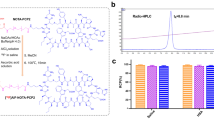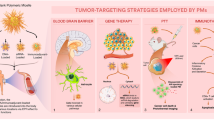Abstract
We previously reported that convection-enhanced delivery (CED) of liposomes into brain tissue and intracranial brain tumor xenografts produced robust tissue distribution that can be detected by magnetic resonance imaging. Considering image-guided CED of therapeutic liposomes as a promising strategy for the treatment of brain tumors, we evaluated the efficacy of pegylated liposomal doxorubicin delivered by CED in an animal model. Distribution, toxicity, and efficacy of pegylated liposomal doxorubicin after CED were evaluated in a U251MG human glioblastoma intracranial xenograft model. CED of pegylated liposomal doxorubicin achieved good distribution in brain tumor tissue and surrounding normal brain tissue. Distribution was not affected by the particle concentration of pegylated liposomal doxorubicin, but tissue toxicity increased at higher concentrations. CED of pegylated liposomal doxorubicin, at a dose not toxic to normal rat brain (0.1 mg/ml doxorubicin), was significantly more efficacious than systemic administration of pegylated liposomal doxorubicin at the maximum tolerated dose. CED of pegylated liposomal doxorubicin resulted in improved survival compared to CED of free doxorubicin at the same dose. Outcomes of this study suggest that CED of liposomal drugs is a promising approach for the treatment of glioblastoma.



Similar content being viewed by others
References
Groothuis DR (2000) The blood–brain and blood–tumor barriers: a review of strategies for increasing drug delivery. Neuro-oncol 2(1):45–59
Bobo RH, Laske DW, Akbasak A, Morrison PF, Dedrick RL, Oldfield EH (1994) Convection-enhanced delivery of macromolecules in the brain. Proc Natl Acad Sci U S A 91(6):2076–2080
Bruce JN, Falavigna A, Johnson JP et al (2000) Intracerebral clysis in a rat glioma model. Neurosurgery 46(3):683–691
Kaiser MG, Parsa AT, Fine RL, Hall JS, Chakrabarti I, Bruce JN (2000) Tissue distribution and antitumor activity of topotecan delivered by intracerebral clysis in a rat glioma model. Neurosurgery 47(6):1391–1398
Degen JW, Walbridge S, Vortmeyer AO, Oldfield EH, Lonser RR (2003) Safety and efficacy of convection-enhanced delivery of gemcitabine or carboplatin in a malignant glioma model in rats. J Neurosurg 99(5):893–898
Lidar Z, Mardor Y, Jonas T et al (2004) Convection-enhanced delivery of paclitaxel for the treatment of recurrent malignant glioma: a phase I/II clinical study. J Neurosurg 100(3):472–479
Allen TM, Martin FJ (2004) Advantages of liposomal delivery systems for anthracyclines. Semin Oncol 31(6 Suppl 13):5–15
Drummond DC, Meyer O, Hong K, Kirpotin DB, Papahadjopoulos D (1999) Optimizing liposomes for delivery of chemotherapeutic agents to solid tumors. Pharmacol Rev 51(4):691–743
Gabizon A, Shmeeda H, Barenholz Y (2003) Pharmacokinetics of pegylated liposomal doxorubicin: review of animal and human studies. Clin Pharmacokinet 42(5):419–436
Thigpen JT, Aghajanian CA, Alberts DS et al (2005) Role of pegylated liposomal doxorubicin in ovarian cancer. Gynecol Oncol 96(1):10–18
Zucchetti M, Boiardi A, Silvani A, Parisi I, Piccolrovazzi S, D’Incalci M (1999) Distribution of daunorubicin and daunorubicinol in human glioma tumors after administration of liposomal daunorubicin. Cancer Chemother Pharmacol 44(2):173–176
Gelmon KA, Tolcher A, Diab AR et al (1999) Phase I study of liposomal vincristine. J Clin Oncol 17(2):697–705
Seiden MV, Muggia F, Astrow A et al (2004) A phase II study of liposomal lurtotecan (OSI-211) in patients with topotecan-resistant ovarian cancer. Gynecol Oncol 93(1):229–232
Zamboni WC, Ramalingam S, Friedland DM et al (2005) Phase I and Pharmacokinetic (PK) study of STEALTH liposomal CKD-602 (S-CKD602) in patients with advanced solid tumors. J Clin Oncol 23:2069 (Meeting abstracts)
Mamot C, Nguyen JB, Pourdehnad M et al (2004) Extensive distribution of liposomes in rodent brains and brain tumors following convection-enhanced delivery. J Neurooncol 68(1):1–9
Saito R, Bringas JR, McKnight TR et al (2004) Distribution of liposomes into brain and rat brain tumor models by convection-enhanced delivery monitored with magnetic resonance imaging. Cancer Res 64(7):2572–2579
Noble CO, Krauze MT, Drummond DC et al (2006) Novel nanoliposomal CPT-11 infused by convection-enhanced delivery in intracranial tumors: pharmacology and efficacy. Cancer Res 66 (5):2801–2806
Bankiewicz KS, Eberling JL, Kohutnicka M et al (2000) Convection-enhanced delivery of AAV vector in parkinsonian monkeys; in vivo detection of gene expression and restoration of dopaminergic function using pro-drug approach. Exp Neurol 164(1):2–14
Hamilton JF, Morrison PF, Chen MY et al (2001) Heparin co-infusion during convection-enhanced delivery (CED) increases the distribution of the glial-derived neurotrophic factor (GDNF) ligand family in rat striatum and enhances the pharmacological activity of neurturin. Exp Neurol 168(1):155–161
Sharma US, Sharma A, Chau RI, Straubinger RM (1997) Liposome-mediated therapy of intracranial brain tumors in a rat model. Pharm Res 14(8):992–998
Zhou R, Mazurchuk R, Straubinger RM (2002) Antivasculature effects of doxorubicin-containing liposomes in an intracranial rat brain tumor model. Cancer Res 62(9):2561–2566
Fabel K, Dietrich J, Hau P et al (2001) Long-term stabilization in patients with malignant glioma after treatment with liposomal doxorubicin. Cancer 92(7):1936–1942
Hau P, Fabel K, Baumgart U et al (2004) Pegylated liposomal doxorubicin efficacy in patients with recurrent high-grade glioma. Cancer 100(6):1199–1207
Kouk\ourakis MI, Koukouraki S, Fezoulidis I et al (2000) High intratumoural accumulation of stealth liposomal doxorubicin (Caelyx) in glioblastomas and in metastatic brain tumours. Br J Cancer 83(10):1281–1286
Barker FG 2nd, Chang SM, Gutin PH et al (1998) Survival and functional status after resection of recurrent glioblastoma multiforme. Neurosurgery 42(4):709–720 (Discussion 20–23)
Gottesman MM, Fojo T, Bates SE (2002) Multidrug resistance in cancer: role of ATP-dependent transporters. Nat Rev Cancer 2(1):48–58
Desoize B, Gimonet D, Jardiller JC (1998) Cell culture as spheroids: an approach to multicellular resistance. Anticancer Res 18(6A):4147–4158
Kolchinsky A, Roninson IB (1997) Drug resistance conferred by MDR1 expression in spheroids formed by glioblastoma cell lines. Anticancer Res 17(5A):3321–3327
Saito R, Krauze MT, Bringas JR et al (2005) Gadolinium-loaded liposomes allow for real-time magnetic resonance imaging of convection-enhanced delivery in the primate brain. Exp Neurol 196(2):381–389
Acknowledgements
Special thanks John Forsayeth Ph.D. for proofreading and editing this work. Grant support: National Cancer Institute Specialized Program of Research Excellence grant (to M. S. Berger, K. S. Bankiewicz, and J. W. Park) and Accelerate Brain Cancer Cure (to K. S. Bankiewicz).
Author information
Authors and Affiliations
Corresponding author
Rights and permissions
About this article
Cite this article
Yamashita, Y., Saito, R., Krauze, M.T. et al. Convection-enhanced delivery of liposomal doxorubicin in intracranial brain tumor xenografts. Targ Oncol 1, 79–85 (2006). https://doi.org/10.1007/s11523-006-0011-8
Received:
Revised:
Accepted:
Published:
Issue Date:
DOI: https://doi.org/10.1007/s11523-006-0011-8




